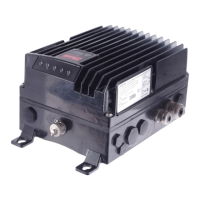38
Instantaneous overcurrent trips are caused by the current rising so fast
on the output that the unit cannot respond. One example of this situation
is in applications where the unit is running at speed and an output
contactor is closed between the unit and the motor. At the point the
contactor is closed, the motor is effectively seen as a short circuit to
the unit. During this time the unit will attempt to gain control of the
motor by employing current limit. If the current limit function is unable
to limit the current to acceptable levels, the result will be an
"OVERCURRENT" trip. This example is not to imply that output
contactors should not be used. In fact, that is quite the contrary as the
VLT has been designed to withstand this type of operation without failure.
The important consideration in applications such as this is that the unit
is properly sized to handle the inrush currents.
A second example of instantaneous overcurrent is that experienced in
applications with windmilling loads. A large fan has not yet been
commanded to run; however, air movement is causing the fan to rotate.
When the unit is started it must first drive the fan to zero speed and
then begin the acceleration process from there. The amount of current
required may be so great and rise so rapidly that the current limit function
cannot control the process. The result is an "OVERCURRENT" trip.
However, this situation can also be solved by a VLT feature "Flying
Start". With the flying start feature employed the VLT will interrogate
the motor to determine its effective frequency and match the VLT output
to that same frequency. Flying start results in a smooth start and full
control of the load current.
Regenerative energy is created when the load overhauls the motor.
This means that the motor is being forced by the inertia of the load to
rotate at a speed greater than the command speed. When overhauling
occurs, the motor acts as a generator and the voltage generated is
returned to the DC capacitor bank in the unit.
Regeneration is most commonly found in applications with high inertia
loads and medium to fast decel ramps. However, even an unloaded
motor ramped fast enough can cause regeneration to occur.
It is most common that regeneration is experienced during ramping,
although loads such as flywheels will generate regenerative energy to
some degree on every cycle.
Since the unit can absorb approximately 15 percent of the motor's rated
power in regenerated energy, this phenomena will go unnoticed in most
applications.
"OVERCURRENT" TRIPS
(CONTINUED)
"OVERVOLTAGE" TRIPS
DUE TO
REGENERATIVE APPLICATIONS

